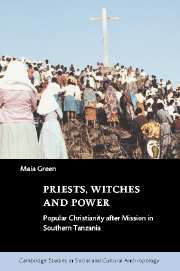26 results
Aid Made Markets: Enclaves, Entrepreneurs and Opportunity in the East African Pharmaceutical Industry - Nitsan Chorev, Give and Take. Developmental Foreign Aid and the Pharmaceutical Industry in East Africa (Princeton, Princeton University Press, 2020, 305 p.)
-
- Journal:
- European Journal of Sociology / Archives Européennes de Sociologie / Volume 61 / Issue 3 / December 2020
- Published online by Cambridge University Press:
- 26 March 2021, pp. 446-449
-
- Article
- Export citation
At the Service of Community Development: The Professionalization of Volunteer Work in Kenya and Tanzania
-
- Journal:
- African Studies Review / Volume 58 / Issue 2 / September 2015
- Published online by Cambridge University Press:
- 01 September 2015, pp. 63-84
-
- Article
- Export citation
Witchcraft Suppression Practices and Movements: Public Politics and the Logic of Purification
-
- Journal:
- Comparative Studies in Society and History / Volume 39 / Issue 2 / April 1997
- Published online by Cambridge University Press:
- 25 April 2012, pp. 319-345
-
- Article
- Export citation
Effect of Patterns of Transferring Patients among Healthcare Institutions on Rates of Nosocomial Methicillin-Resistant Staphylococcus aureus Transmission: A Monte Carlo Simulation
-
- Journal:
- Infection Control & Hospital Epidemiology / Volume 32 / Issue 2 / February 2011
- Published online by Cambridge University Press:
- 02 January 2015, pp. 136-147
- Print publication:
- February 2011
-
- Article
- Export citation
List of maps
-
- Book:
- Priests, Witches and Power
- Published online:
- 22 September 2009
- Print publication:
- 06 March 2003, pp vi-vi
-
- Chapter
- Export citation
List of references
-
- Book:
- Priests, Witches and Power
- Published online:
- 22 September 2009
- Print publication:
- 06 March 2003, pp 156-167
-
- Chapter
- Export citation
7 - Engendering power
-
- Book:
- Priests, Witches and Power
- Published online:
- 22 September 2009
- Print publication:
- 06 March 2003, pp 91-106
-
- Chapter
- Export citation
Contents
-
- Book:
- Priests, Witches and Power
- Published online:
- 22 September 2009
- Print publication:
- 06 March 2003, pp v-v
-
- Chapter
- Export citation
Index
-
- Book:
- Priests, Witches and Power
- Published online:
- 22 September 2009
- Print publication:
- 06 March 2003, pp 168-180
-
- Chapter
- Export citation
4 - The persistence of mission
-
- Book:
- Priests, Witches and Power
- Published online:
- 22 September 2009
- Print publication:
- 06 March 2003, pp 46-59
-
- Chapter
- Export citation
5 - Popular Christianity
-
- Book:
- Priests, Witches and Power
- Published online:
- 22 September 2009
- Print publication:
- 06 March 2003, pp 60-74
-
- Chapter
- Export citation
2 - Colonial conquest and the consolidation of marginality
-
- Book:
- Priests, Witches and Power
- Published online:
- 22 September 2009
- Print publication:
- 06 March 2003, pp 14-33
-
- Chapter
- Export citation
1 - Global Christianity and the structure of power
-
- Book:
- Priests, Witches and Power
- Published online:
- 22 September 2009
- Print publication:
- 06 March 2003, pp 1-13
-
- Chapter
- Export citation
9 - Witchcraft suppression practices and movements
-
- Book:
- Priests, Witches and Power
- Published online:
- 22 September 2009
- Print publication:
- 06 March 2003, pp 120-140
-
- Chapter
- Export citation
Preface
-
- Book:
- Priests, Witches and Power
- Published online:
- 22 September 2009
- Print publication:
- 06 March 2003, pp vii-xiv
-
- Chapter
- Export citation

Priests, Witches and Power
- Popular Christianity after Mission in Southern Tanzania
-
- Published online:
- 22 September 2009
- Print publication:
- 06 March 2003
6 - Kinship and the creation of relationship
-
- Book:
- Priests, Witches and Power
- Published online:
- 22 September 2009
- Print publication:
- 06 March 2003, pp 75-90
-
- Chapter
- Export citation
Frontmatter
-
- Book:
- Priests, Witches and Power
- Published online:
- 22 September 2009
- Print publication:
- 06 March 2003, pp i-iv
-
- Chapter
- Export citation
3 - Evangelisation in Ulanga
-
- Book:
- Priests, Witches and Power
- Published online:
- 22 September 2009
- Print publication:
- 06 March 2003, pp 34-45
-
- Chapter
- Export citation
Cambridge Studies in Social and Cultural Anthropology
-
- Book:
- Priests, Witches and Power
- Published online:
- 22 September 2009
- Print publication:
- 06 March 2003, pp 181-184
-
- Chapter
- Export citation

